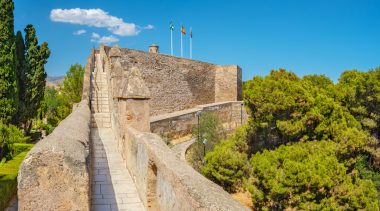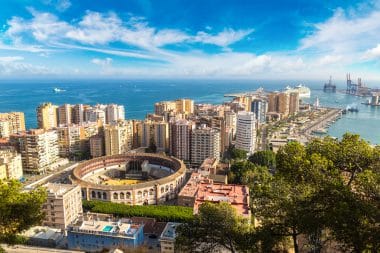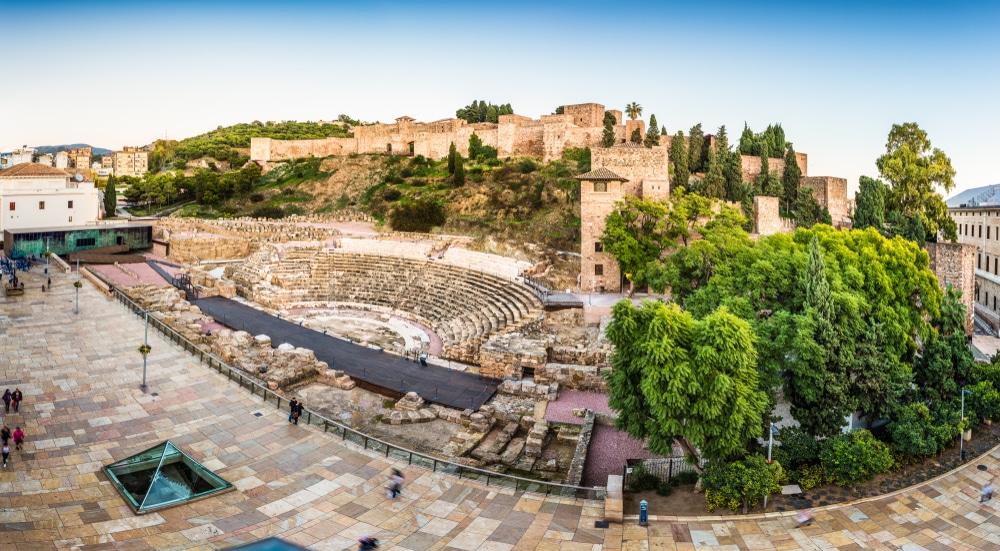As the second largest city in Andalusia, Malaga has some real treasures in store. History, art and culture meet here in a miraculous mixture. From antiquity to the present day, the city can be experienced in all its facets. Rent a car from CarGest Malaga without excess and visit the most beautiful sights of the city.
Alcazaba – Fortress of the City
The Alcazaba palace complex has towered over the city since the 11th century. It was not until the early 19th century that parts of the fortress were destroyed by Napoleon Bonaparte’s army. In 1933, restoration work was carried out and archaeological investigations were carried out. The complex is connected to the Gibralfaro fortress by a fortified passage (called “coracha”).
Visitors are welcome at the fortress after paying an entrance fee and can enjoy the architecture as well as the view over the city, harbour and surrounding area. Special exhibitions are also held within the palace from time to time.
The complex also includes a Roman theatre, which is located at the foot of the castle hill. It is the most important relic from Roman times and dates back to the 1st century. However, it lost its importance as early as the 3rd century and was later partially demolished by the Arabs for the construction of Alcazaba. It was not rediscovered until 1951.
Castillo de Gibralfaro – Protective castle with a view

Once built to protect the Alcazaba fortress, the Castillo de Gibralfaro is now a tourist attraction. The castle hill Jbel-Faro was already fortified in ancient times. In the 10th century, a fortress was built on these remains, which was expanded in 1340.
In 1487, Isabella I of Castile and Ferdinand II of Aragon besieged the fortress for three months in the summer, after which they had taken the castle and also Alcazaba. The king took the castle as his residence, while his wife Isabella lived in the city. Since 1931, the fortress has been considered a historical monument and can now be visited by visitors, although this is worthwhile not only because of the architecture and history, but also because of the view of the Strait of Gibraltar.
Catedral de la Encarnación – Cathedral of the Incarnation of God
In the city centre, the cathedral of Malaga with the long name Santa Iglesia Catedral Basílica de la Encarnación stands on a site that was occupied by a mosque before 1528. Since only one tower was completed due to lack of money, the church is nicknamed “La Manquita”, which means “little one-armed lady”.
It was built for over 250 years, which resulted in a highly appealing mix of architectural styles. While it is mostly Renaissance style, there are also Gothic, Baroque, and Neoclassical elements.
Jardín Botánico-Histórico La Concepción – The city’s green oasis
The tropical garden in the northern part of the city was created in 1855. Palace-like buildings, waterfalls, fountains, pavilions and a variety of indigenous, subtropical and tropical plants create a unique atmosphere. In 1990, the former private garden was bought by the city, opened to the public in 1994 and gradually more themed gardens were added. For example, the “Cactus Garden” and the “Garden of Primordial Plants”. With its diverse botany, the garden also provided the perfect backdrop for several films. Most recently, for example, in 2003 for “The Bridge of San Luis Rey”.
The bullring – Spanish tradition

An improbable picture is the imposing bullring, which seems so small in the middle of the skyscrapers. The arena, built in 1874, offers space for almost 9,000 spectators. In addition to bullfights – which take place mainly in August – you can also see a museum around this Spanish tradition in the building, which may be an easier choice for those interested compared to the bloody fights. Today, the arena is also used for the training of noble horses. But you can also visit the arena for architectural reasons. The architect Joaquín Rucoba was a master at combining Renaissance architecture with influences from Islam, which is what makes up the Spanish Neo-Mudejar style.
Picasso Museum & Birthplace – The great artist up close
Both buildings – the museum and the birthplace – are close to each other.
While the museum provides an overview of all Picasso’s creative periods with over 200 works, the birthplace provides intimate insights into the origins of the well-known artist. The former is located in the Palacio de los Condes de Buenavista, which was built in the first half of the 16th century. In 1997, the city bought the building to turn it into the first Picasso museum in his birthplace, and since 2003 the doors have been open to art lovers. In Plaza de la Merced 36 is the house where Pablo Picasso was born on October 25, 1881 and also spent the first ten years of his childhood. For visitors, the house was furnished in the style of the late 19th century and some original objects of the family can also be admired there. In addition, since 1998 there has also been a documentation center that exhibits works of art by Picasso as well as contemporary artists.
Our tip: Take advantage of car rental malaga directly at the airport. This way you can reach your accommodation as quickly as possible.


